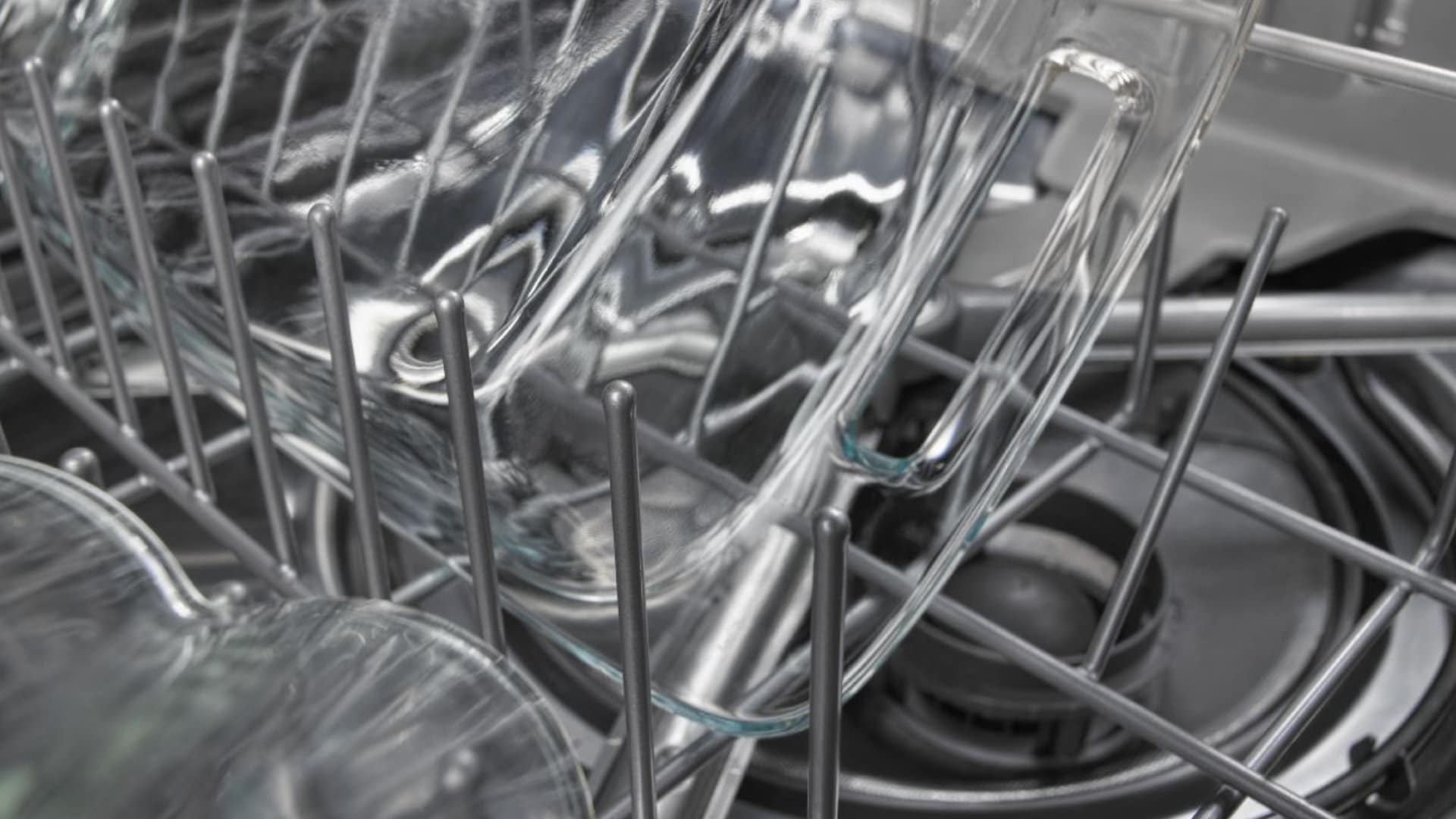
Most KitchenAid dishwashers come with a filter system to stop food chunks or foreign objects from clogging up the drain hose or damaging the pump. Depending on your model, KitchenAid dishwashers usually have an upper and lower filter assembly. The upper filter assembly is designed to stop debris from getting into the drainage system, while the lower filter prevents food scraps from being recirculated onto the dishes.
Cleaning the dishwasher filters is a relatively easy task; however, abrasive or coarse cleaning tools, like wire brushes or scouring pads, should not be used to avoid damaging the filters.
This guide applies to most KitchenAid dishwashers, including the following models:
4KPDI620T0, 4KPDI620T1, 4KPDI620T2, 4KPDI620T3, 4KUDA220T0, 4KUDA220T1, KDFE104DSS0, KDTE104DSS0, KDTE104ESS1, KDTE204DSS0, KDTE254ESS2, KDTE334DSS0, KDTM354DSS4, KUDC10FXSS5, KUDS01FLSS0, KUDS01FLSS6, KUDS30FXSS5, KUDS30IXSS4, KUDS35FXSS5, KUDS35FXSS9, KUDS35FXSSA
When should you clean the dishwasher’s filters?
Depending on how often the dishwasher is used (and if your home has hard water), its filters may require cleaning anytime from once a week to once a year.
If your home is affected by hard water (calcium and magnesium buildup on sink and tub fixtures), the filter should be cleaned monthly.
KitchenAid offers this guidance for how often you should clean the filter:
| Number of loads per week | If you wash before loading | If you scrape & rinse before loading | If you only scrape before loading | If you do not scrape or rinse before loading |
| 1-3 | Once per year | Once per year | Twice per year | Every 2 months |
| 4-7 | Once per year | Once per year | Twice per year | Once per month |
| 8-12 | Once per year | Twice per year | Every 3 months | Every 2 weeks |
| 13-14 | Once per year | Twice per year | Every 3 months | Once per week |
You should also clean the filter if you observe:
- There is excessive debris, grime, and grease on the upper filter assembly.
- Dishes are not being washed well enough.
- Dishes feel gritty after washing.
- The dishwasher is not draining properly.
How to remove the KitchenAid dishwasher filter
Note that some older KitchenAid dishwashers may not have a removable lower filter. Once the upper filter is removed, the lower filter should come out without too much effort.
Step 1: Remove the bottom dish rack and cutlery basket.
Step 2: Locate the upper filter, a circular filter with approximately a 4-inch diameter near the center of the tub.
Step 3: Turn the upper filter assembly ¼ counterclockwise and lift it out.
Step 4: Locate the lower filter, a flat, usually mesh, half-circle filter in the center of the tub.
Step 5: Grasp the lower filter in the circular opening, lift slightly, and pull forward to remove it.
How to clean the filters
- Rinse the filters under running water.
- If debris is difficult to remove, clean carefully with a soft brush (do not use potentially damaging cleaning tools, like wire brushes or scouring pads).
- A soft toothbrush can be used for hard-to-reach parts of the filter.
- Dish soap can be used, but make sure to thoroughly rinse it off as you don’t want additional detergent in the dishwasher (it might cause excessive suds, which can trigger error codes and drainage or leaking issues).
Stubborn stains, residue, mineral deposits
If there is stubborn calcium, detergent, or food residue, distilled white vinegar will help remove it.
Either pour white vinegar over the filter or place the filter in a bowl of white vinegar and leave to soak for 30 minutes to an hour.
After soaking, clean the filter following the steps above.
How to reinstall the filters
Step 1: Place the lower filter under the locating tabs at the bottom of the dishwasher so that the round opening for the upper filter aligns with the round opening at the bottom of the tub.
Step 2: Insert the upper filter into the round opening in the lower filter.
Step 3: Carefully rotate the upper filter clockwise until it drops and locks into place.
Step 4: Make sure both filters are secure. If the upper filter turns freely, it hasn’t locked into place.
Step 5: Return the lower dishrack and cutlery basket to the dishwasher.
Do not operate the dishwasher without the filters or without them being secured in the dishwasher tub, as it will likely damage the dishwasher.
What happens if you don’t clean the filters?
The filters stop food debris or residue, grime, and foreign items like broken glass from getting into the system and damaging components like the pump and drain hose. If the filters aren’t cleaned, the debris may damage the filter and damage the dishwasher.
If the filter becomes clogged, the dishwasher’s performance will be hindered, and drainage and leaking issues may occur. Clogged filters can also cause unwanted odors.

How to Resolve the Bosch Dishwasher E15 Error Code

How to Balance a Washing Machine (5 Quick Tips)

Solutions for a Frigidaire Gas Stove Oven Failure

How to Fix a GE Ice Maker Not Working (Quick Fixes)

How to Fix the Electrolux Dryer Error Code E64

Is Your Whirlpool Ice Maker Not Working? Here’s Why

Can Styrofoam Be Microwaved? (Safety and Risks)

Agitator vs. No Agitator Washer: What’s Best?

Why Is Your Refrigerator Compressor Hot? (6 Potential Causes)

How to Use Dishwasher Pods

How to Unlock Your Microwave

How Many Watts Does a Refrigerator Use?

How To Fix a KitchenAid Dishwasher That Isn’t Draining

GE Oven F2 Error Code: Causes & Solutions

Maytag Washer Not Spinning? 5 Simple Solutions

Why Is Your Refrigerator Not Cooling?

How to Get Rid of Burnt Smell in Microwave

How to Fix a Dishwasher Not Cleaning Properly

How Much Energy Does My Dryer Use?


